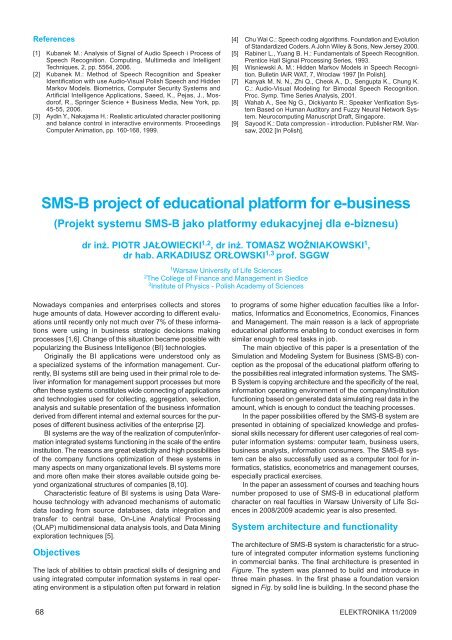Elektronika 2009-11.pdf - Instytut Systemów Elektronicznych
Elektronika 2009-11.pdf - Instytut Systemów Elektronicznych
Elektronika 2009-11.pdf - Instytut Systemów Elektronicznych
You also want an ePaper? Increase the reach of your titles
YUMPU automatically turns print PDFs into web optimized ePapers that Google loves.
References<br />
[1] Kubanek M.: Analysis of Signal of Audio Speech i Process of<br />
Speech Recognition. Computing, Multimedia and Intelligent<br />
Techniques, 2, pp. 5564, 2006.<br />
[2] Kubanek M.: Method of Speech Recognition and Speaker<br />
Identification with use Audio-Visual Polish Speech and Hidden<br />
Markov Models. Biometrics, Computer Security Systems and<br />
Artificial Intelligence Applications, Saeed, K., Pejas, J., Mosdorof,<br />
R., Springer Science + Business Media, New York, pp.<br />
45-55, 2006.<br />
[3] Aydin Y., Nakajama H.: Realistic articulated character positioning<br />
and balance control in interactive environments. Proceedings<br />
Computer Animation, pp. 160-168, 1999.<br />
[4] Chu Wai C.: Speech coding algorithms. Foundation and Evolution<br />
of Standardized Coders. A John Wiley & Sons, New Jersey 2000.<br />
[5] Rabiner L., Yuang B. H.: Fundamentals of Speech Recognition.<br />
Prentice Hall Signal Processing Series, 1993.<br />
[6] Wisniewski A. M.: Hidden Markov Models in Speech Recognition.<br />
Bulletin IAiR WAT, 7, Wroclaw 1997 [In Polish].<br />
[7] Kanyak M. N. N., Zhi Q., Cheok A., D., Sengupta K., Chung K.<br />
C.: Audio-Visual Modeling for Bimodal Speech Recognition.<br />
Proc. Symp. Time Series Analysis, 2001.<br />
[8] Wahab A., See Ng G., Dickiyanto R.: Speaker Verification System<br />
Based on Human Auditory and Fuzzy Neural Network System.<br />
Neurocomputing Manuscript Draft, Singapore.<br />
[9] Sayood K.: Data compression - introduction. Publisher RM. Warsaw,<br />
2002 [In Polish].<br />
SMS-B project of educational platform for e-business<br />
(Projekt systemu SMS-B jako platformy edukacyjnej dla e-biznesu)<br />
dr inż. PIOTR JAŁOWIECKI 1,2 , dr inż. TOMASZ WOŹNIAKOWSKI 1 ,<br />
dr hab. ARKADIUSZ ORŁOWSKI 1,3 prof. SGGW<br />
1 Warsaw University of Life Sciences<br />
2 The College of Finance and Management in Siedlce<br />
3 Institute of Physics - Polish Academy of Sciences<br />
Nowadays companies and enterprises collects and stores<br />
huge amounts of data. However according to different evaluations<br />
until recently only not much over 7% of these informations<br />
were using in business strategic decisions making<br />
processes [1,6]. Change of this situation became possible with<br />
popularizing the Business Intelligence (BI) technologies.<br />
Originally the BI applications were understood only as<br />
a specialized systems of the information management. Currently,<br />
BI systems still are being used in their primal role to deliver<br />
information for management support processes but more<br />
often these systems constitutes wide connecting of applications<br />
and technologies used for collecting, aggregation, selection,<br />
analysis and suitable presentation of the business information<br />
derived from different internal and external sources for the purposes<br />
of different business activities of the enterprise [2].<br />
BI systems are the way of the realization of computer/information<br />
integrated systems functioning in the scale of the entire<br />
institution. The reasons are great elasticity and high possibilities<br />
of the company functions optimization of these systems in<br />
many aspects on many organizational levels. BI systems more<br />
and more often make their stores available outside going beyond<br />
organizational structures of companies [8,10].<br />
Characteristic feature of BI systems is using Data Warehouse<br />
technology with advanced mechanisms of automatic<br />
data loading from source databases, data integration and<br />
transfer to central base, On-Line Analytical Processing<br />
(OLAP) multidimensional data analysis tools, and Data Mining<br />
exploration techniques [5].<br />
Objectives<br />
The lack of abilities to obtain practical skills of designing and<br />
using integrated computer information systems in real operating<br />
environment is a stipulation often put forward in relation<br />
to programs of some higher education faculties like a Informatics,<br />
Informatics and Econometrics, Economics, Finances<br />
and Management. The main reason is a lack of appropriate<br />
educational platforms enabling to conduct exercises in form<br />
similar enough to real tasks in job.<br />
The main objective of this paper is a presentation of the<br />
Simulation and Modeling System for Business (SMS-B) conception<br />
as the proposal of the educational platform offering to<br />
the possibilities real integrated information systems. The SMS-<br />
B System is copying architecture and the specificity of the real,<br />
information operating environment of the company/institution<br />
functioning based on generated data simulating real data in the<br />
amount, which is enough to conduct the teaching processes.<br />
In the paper possibilities offered by the SMS-B system are<br />
presented in obtaining of specialized knowledge and professional<br />
skills necessary for different user categories of real computer<br />
information systems: computer team, business users,<br />
business analysts, information consumers. The SMS-B system<br />
can be also successfully used as a computer tool for informatics,<br />
statistics, econometrics and management courses,<br />
especially practical exercises.<br />
In the paper an assessment of courses and teaching hours<br />
number proposed to use of SMS-B in educational platform<br />
character on real faculties in Warsaw University of Life Sciences<br />
in 2008/<strong>2009</strong> academic year is also presented.<br />
System architecture and functionality<br />
The architecture of SMS-B system is characteristic for a structure<br />
of integrated computer information systems functioning<br />
in commercial banks. The final architecture is presented in<br />
Figure. The system was planned to build and introduce in<br />
three main phases. In the first phase a foundation version<br />
signed in Fig. by solid line is building. In the second phase the<br />
68 ELEKTRONIKA 11/<strong>2009</strong>

















